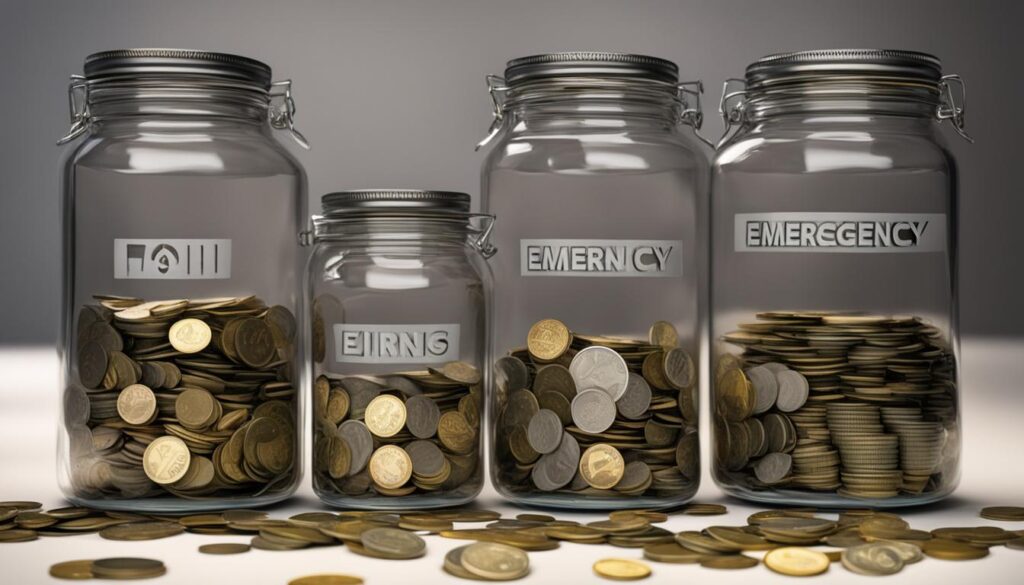In your 30s, it’s crucial to start managing your financial risks to secure your financial future. A recent survey revealed that 9 in 10 adults believe that having their finances in order brings happiness and confidence. This comprehensive guide will walk you through the seven key steps to focus on for long-term financial security, including setting short-term and long-term goals.
Key Takeaways:
- Managing financial risks in your 30s is vital for long-term financial security.
- Setting clear short-term and long-term goals is crucial for building financial stability.
- Creating a budget helps prioritize essential costs, discretionary expenses, and savings.
- Building an emergency fund provides a financial cushion for unexpected expenses.
- Paying off credit card debt frees up money for savings and other financial goals.
Setting Short-term and Long-term Goals
In order to build financial security in your 30s, it is crucial to set clear goals for both the short-term and the long-term. Short-term goals are essential for immediate financial stability, while long-term goals focus on securing your financial future. By establishing these goals, you can take proactive steps towards achieving financial success.
The Importance of Short-term Goals
Short-term goals serve as a foundation for your financial journey. They can include building an emergency fund, paying off credit card debt, and creating a budget. These goals address immediate financial needs and help you develop good financial habits.
The Significance of Long-term Goals
Long-term goals are essential for creating a financially secure future. They often involve saving for retirement, education expenses, or a down payment on a home. By setting long-term goals early on, you can take advantage of the power of compounding and ensure a comfortable and secure future.
| Short-term Goals | Long-term Goals |
|---|---|
| Build an emergency fund | Save for retirement |
| Pay off credit card debt | Invest in education savings |
| Create a budget | Save for a down payment on a home |
By setting both short-term and long-term goals, you can establish a well-rounded financial plan that addresses both immediate needs and long-term aspirations. It is important to regularly review and adjust these goals as your financial situation evolves.
Now that you understand the importance of setting short-term and long-term goals, it’s time to dive deeper into creating a budget to effectively manage your finances.
Creating a Budget
Creating a budget is an essential step in managing your finances effectively. It allows you to gain a clear understanding of your income and expenses, helping you make informed decisions about your spending and saving habits. By following a budget, you can prioritize your financial goals and ensure that you are living within your means while also saving for the future.
One popular approach to budgeting is the 50/30/20 rule. This rule suggests dividing your after-tax income into three categories: 50% for essential costs, 30% for discretionary expenses, and 20% for savings. Essential costs include necessities such as rent or mortgage payments, utilities, groceries, and transportation. Discretionary expenses cover non-essential items like dining out, entertainment, and personal care. Finally, the remaining 20% is allocated towards savings for your short-term and long-term goals.
Creating a detailed breakdown of your expenses can help you identify areas where you can cut back and allocate more towards your savings goals. Consider tracking your expenses for a month to get an accurate picture of your spending habits. Look for opportunities to reduce discretionary expenses and find ways to save on essential costs without sacrificing quality of life. This could include negotiating bills, shopping for better deals, or finding creative ways to enjoy affordable entertainment.
Remember, budgeting is an ongoing process that requires regular evaluation and adjustment. As your financial situation changes and your goals evolve, it’s important to revisit and update your budget accordingly. By staying committed to your budgeting efforts, you can take control of your finances and make progress towards achieving your financial goals.
| Essential Costs | Discretionary Expenses | Savings |
|---|---|---|
| Housing | Dining out | Emergency Fund |
| Utilities | Entertainment | Retirement Savings |
| Groceries | Travel | Education Savings |
| Transportation | Personal Care | Other Goals |
Building an Emergency Fund
In times of unexpected expenses or financial emergencies, having an emergency fund can provide the much-needed financial cushion. An emergency fund is a dedicated savings account specifically set aside to cover unforeseen costs, such as medical bills, car repairs, or job loss. It acts as a safety net, ensuring that you don’t have to rely on credit cards or take on high-interest loans to navigate through challenging times.
Experts recommend saving at least three to six months’ worth of living expenses in your emergency fund. This amount may vary depending on individual circumstances, such as job stability and personal risk tolerance. By having this financial buffer, you can feel more secure and confident in facing unexpected situations without compromising your long-term financial goals.
“An emergency fund is like insurance for your financial well-being. It gives you peace of mind and the ability to handle unexpected expenses without resorting to debt,” says financial advisor Jane Smith.
To build an emergency fund, start by setting a specific savings goal and determine how much you can comfortably set aside each month. Treat your emergency fund contribution as a non-negotiable expense, just like paying your bills. Consider automating your savings by setting up an automatic transfer from your checking account to your emergency fund account every payday. This way, you’ll consistently contribute to your fund without having to remember to do it manually.

Saving Tips for Building an Emergency Fund
- Review your monthly expenses and look for areas where you can cut back to increase your monthly savings amount.
- Consider additional sources of income, such as a part-time job or freelancing, to accelerate your emergency fund contributions.
- Regularly reassess your savings goal as your financial circumstances and priorities may change over time.
By diligently building your emergency fund, you can be better prepared to handle unexpected financial challenges and have the peace of mind that comes with having a solid financial foundation.
| Pros of Building an Emergency Fund | Cons of Not Having an Emergency Fund |
|---|---|
|
|
Paying off Credit Card Debt
If you’re carrying credit card debt, it’s essential to prioritize paying it off to improve your financial security. Credit card debt often comes with high-interest rates, which can make it challenging to make significant progress in reducing your debt. However, there are several strategies you can employ to tackle your credit card debt effectively.
Balance Transfer
One option is to consider a balance transfer to a credit card with a lower interest rate. This can help save on interest payments and allow you to pay off your debt more efficiently. Before opting for a balance transfer, make sure to read the terms and conditions, including any balance transfer fees, to ensure it’s the right move for you.
Debt Repayment Strategies
When it comes to repaying credit card debt, two popular strategies are the avalanche method and the snowball method. The avalanche method involves paying off debts with the highest interest rates first, while making minimum payments on other debts. This strategy can save you more money in the long run by reducing the total interest paid.
On the other hand, the snowball method focuses on paying off smaller debts first, regardless of interest rates. The idea behind this strategy is to gain momentum and motivation by achieving quick wins. As you pay off smaller debts, you can then use the extra money to tackle larger debts. Choose the strategy that aligns with your financial goals and helps you stay motivated in your debt repayment journey.

| Debt Repayment Strategy | Pros | Cons |
|---|---|---|
| Avalanche Method | – Saves more money on interest payments – Reduces total debt faster | – May take longer to pay off smaller debts – Requires discipline and patience |
| Snowball Method | – Provides quick wins and motivation – Streamlines debt repayment process | – May result in higher interest payments – Could take longer to eliminate higher-interest debts |
Remember, paying off credit card debt is a crucial step towards improving your financial health. By exploring different strategies and consistently making payments, you can regain control of your finances and work towards a debt-free future.
Saving for Retirement
In your 30s, it’s crucial to start saving for retirement to ensure a comfortable future. By taking advantage of compound interest and retirement accounts, you can maximize your savings and secure your financial well-being. This section will guide you through the various strategies and options available to help you save for retirement effectively.

Retirement Accounts: One of the primary ways to save for retirement is through retirement accounts such as a 401(k) or an individual retirement account (IRA). These accounts offer tax advantages, allowing your savings to grow over time. Contribute as much as you can to these accounts, especially if your employer offers a matching contribution.
Compound Interest: Start saving for retirement as early as possible to take advantage of compound interest. The earlier you start, the longer your savings have to grow and accumulate interest. Even small contributions can make a significant difference in the long run.
Employer Match: If your employer offers a matching contribution to your retirement account, ensure you contribute enough to take full advantage of this benefit. It’s essentially free money that can significantly boost your retirement savings.
Tax Advantages of Retirement Accounts
Retirement accounts offer tax advantages that can further enhance your savings. Contributions to traditional retirement accounts are made with pre-tax dollars, reducing your taxable income for the year. This means you’ll pay less in taxes upfront. Additionally, the growth in your retirement account is tax-deferred, allowing your savings to compound without being taxed until you withdraw the funds during retirement.
| Retirement Account Type | Tax Advantage |
|---|---|
| 401(k) | Pre-tax contributions and tax-deferred growth |
| Traditional IRA | Pre-tax contributions and tax-deferred growth |
| Roth IRA | Tax-free withdrawals during retirement |
It’s important to note that while traditional retirement accounts offer immediate tax benefits, Roth IRAs provide tax-free withdrawals during retirement. Consider your current and future tax situation when choosing between the two options. Consulting with a financial advisor can help you make informed decisions based on your individual circumstances.
Taking Calculated Risks
Taking calculated risks in your 30s can pave the way for significant financial growth and independence. It’s a time when you have the energy, drive, and capacity to explore new job opportunities and advance your career. By strategically evaluating potential risks and rewards, you can make informed decisions that align with your long-term financial goals and aspirations. By embracing these opportunities, you can not only enhance your income but also build a robust professional network that may open doors for future endeavors. Moreover, as you navigate this dynamic phase, it’s essential to master insurance planning strategies to safeguard your financial progress against unexpected setbacks. By doing so, you not only protect your assets but also position yourself for long-term stability and success in your financial journey.
When it comes to job opportunities, consider expanding your horizons by exploring cities or regions with a thriving job market in your field. Moving to a location with more job prospects can open doors to better career opportunities and higher earning potential. While it may involve leaving behind familiar surroundings, the long-term benefits of a promising job market can far outweigh the temporary discomfort of relocating.
Career advancement is another avenue for taking calculated risks. Don’t be afraid to pursue opportunities that offer long-term growth potential, even if they initially come with a lower salary. By investing in your skills and knowledge through additional education or training, you can position yourself for promotions and higher-paying positions in the future. Remember, the potential for career advancement often leads to increased financial independence.
“The biggest risk is not taking any risk… In a world that is changing quickly, the only strategy that is guaranteed to fail is not taking risks.”
– Mark Zuckerberg
Investments are another area where calculated risks can lead to financial prosperity. Diversifying your investments across different asset classes, such as stocks, bonds, and real estate, can help mitigate risks and maximize potential returns. It’s crucial to conduct thorough research, seek professional advice, and understand your risk tolerance before making any investment decisions. Remember, investments should align with your long-term financial goals and be part of a well-balanced financial plan.
Table: Comparison of Potential Job Opportunities
| City | Job Market | Cost of Living | Salary Range |
|---|---|---|---|
| New York City | Highly competitive with diverse industries | High | $50,000 – $200,000+ |
| Austin | Rapidly growing tech and startup hub | Moderate | $40,000 – $150,000+ |
| Seattle | Booming tech industry and major corporations | High | $50,000 – $180,000+ |
| Denver | Emerging tech and outdoor recreation industries | Moderate | $45,000 – $160,000+ |
| Atlanta | Growing film, healthcare, and technology sectors | Moderate | $40,000 – $140,000+ |
Conclusion
Achieving financial security in your 30s is crucial for setting a strong foundation for your future. By focusing on risk management and implementing key strategies, you can take control of your finances and work towards your goals.
Setting clear financial goals is the first step towards success. Whether it’s saving for retirement, creating an emergency fund, or paying off credit card debt, having a roadmap will keep you on track.
Creating a budget is another essential tool for managing your money effectively. Balancing your essential costs, discretionary expenses, and savings ensures that you’re living within your means while also saving for the future.
Building an emergency fund provides a much-needed safety net in case of unexpected expenses. With three to six months’ worth of living expenses saved, you’ll have peace of mind and the ability to weather any financial storm.
Paying off credit card debt is a critical step towards financial security. By reducing high-interest payments and freeing up more money for savings, you’ll be able to make significant progress towards your goals.
Saving for retirement is not something to put off. Starting early allows your money to grow through compound interest, ensuring a comfortable retirement lifestyle. Take advantage of employer-sponsored retirement accounts or individual retirement accounts to maximize your savings.
In your 30s, it’s important to take calculated risks that can lead to financial growth and independence. Explore opportunities for career advancement, further education, and investment options that align with your risk tolerance and long-term goals.
By following the steps outlined in this comprehensive guide, you can embark on a journey towards financial security, setting and achieving your financial goals, and effectively managing risks in your 30s.
FAQ
How important is it to set financial goals in your 30s?
Setting financial goals in your 30s is crucial for long-term financial security. It helps you prioritize your spending, save for emergencies, and plan for retirement and other major expenses.
What are some short-term financial goals to consider in your 30s?
Short-term financial goals can include building an emergency fund, paying off credit card debt, and creating a budget to manage your expenses effectively.
What are some long-term financial goals to consider in your 30s?
Long-term financial goals can include saving for retirement by contributing to retirement accounts, saving for a down payment on a home, or saving for a child’s education.
How can I create a budget to manage my finances effectively?
A popular budgeting framework is the 50/30/20 rule, which suggests allocating 50% of your after-tax income for essential costs, 30% for discretionary expenses, and 20% for savings.
Why is building an emergency fund important?
Building an emergency fund provides a financial cushion for unexpected expenses. It helps reduce stress and ensures you can handle financial challenges without relying on credit cards or loans.
How can I pay off credit card debt and improve my financial security?
Consider transferring high-interest credit card balances to a card with a lower interest rate. You can also employ debt repayment strategies like the avalanche method or the snowball method to pay off debts strategically.
When should I start saving for retirement?
It’s never too early to start saving for retirement. The power of compound interest makes saving early even more beneficial. If you have access to an employer-sponsored retirement account, such as a 401(k), take advantage of it. Otherwise, you can contribute to an individual retirement account (IRA).
How can I take calculated risks to improve my financial situation in my 30s?
Taking calculated risks can involve exploring job opportunities with potential for long-term growth, furthering your education, or considering investments that align with your risk tolerance and financial goals.
How Does Ethical Investing Help Manage Financial Risks in Your 30s?
As you navigate your 30s, an ethical investing guide for socially responsible 30s can play a significant role in managing financial risks. By aligning your investments with your values, ethical investing allows you to support companies that prioritize environmental, social, and governance practices, reducing the likelihood of financial risks associated with unethical practices. Such investments not only provide potential financial returns but also contribute to a sustainable and ethical future.


Pingback: Mastering Wealth Management in Your Early 30s – Straight Fire Money